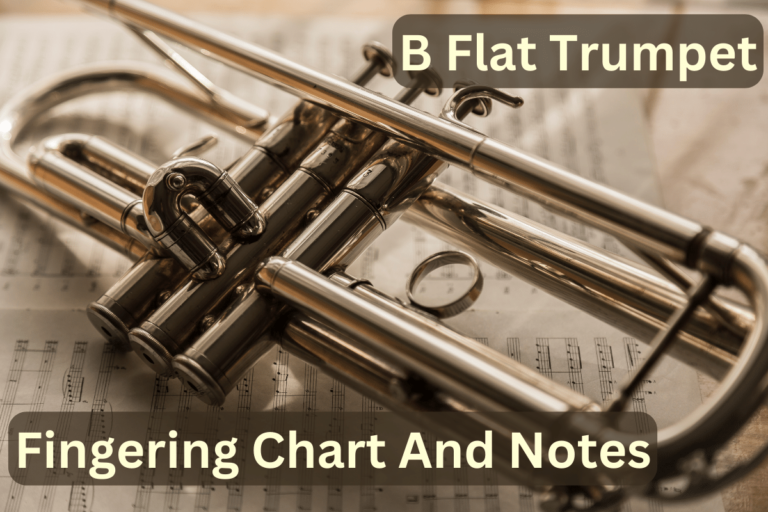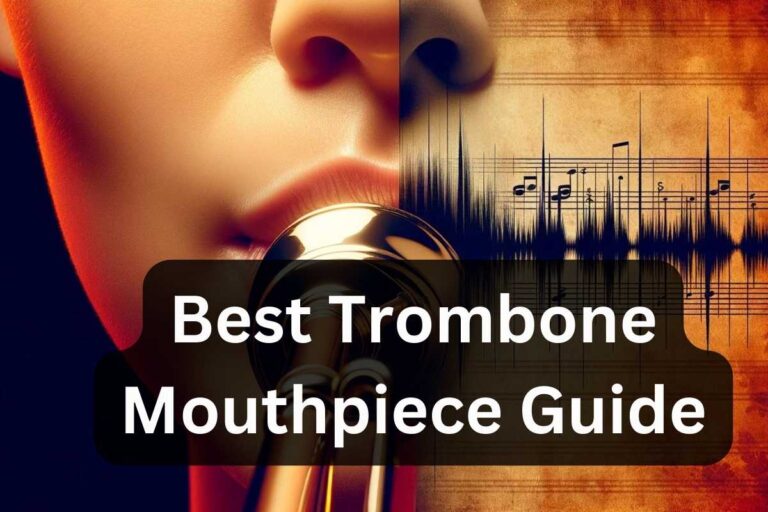Easiest Instrument To Learn – 28 Best Picks To Start in 2024

Are You Searching for the easiest instrument to learn in 2021? I have put together a list of 27 instruments considered among the easiest.
No matter where your musical journey may lead you — whether starting from scratch or honing your existing skillset — there is something suitable here for every musician!! Let’s explore these accessible yet engaging instruments suitable for adults and kids.
Key Takeaways
- Begin your musical journey by choosing easy-to-learn instruments like harmonicas, recorders and bongo drums as a place to begin learning musical notes and rhythm.
- Discover a variety of musical styles by exploring kazoo, steelpan and tambourine instruments.
- Take on more challenging instruments such as trumpet, electric guitar or violin and experience beautiful music creation!
Discover new musical instruments? Take a look at this list of 35 Band Instruments – Full List for School & Rock Beginners 2023
Top 3 Easiest Musical Instruments To Learn for Adults
Three instruments known for being easy to learn include the harmonica, recorder and bongo.
Not only can these instruments be easily learned — there’s a wide range of musical styles you can explore too!!
Have fun discovering something new with these top 3 easiest instruments designed for adults looking to learn something fresh today!
1 Harmonica
The harmonica is a highly accessible instrument, making it one of the most straightforward musical instruments to master. It’s not technically considered a woodwind.
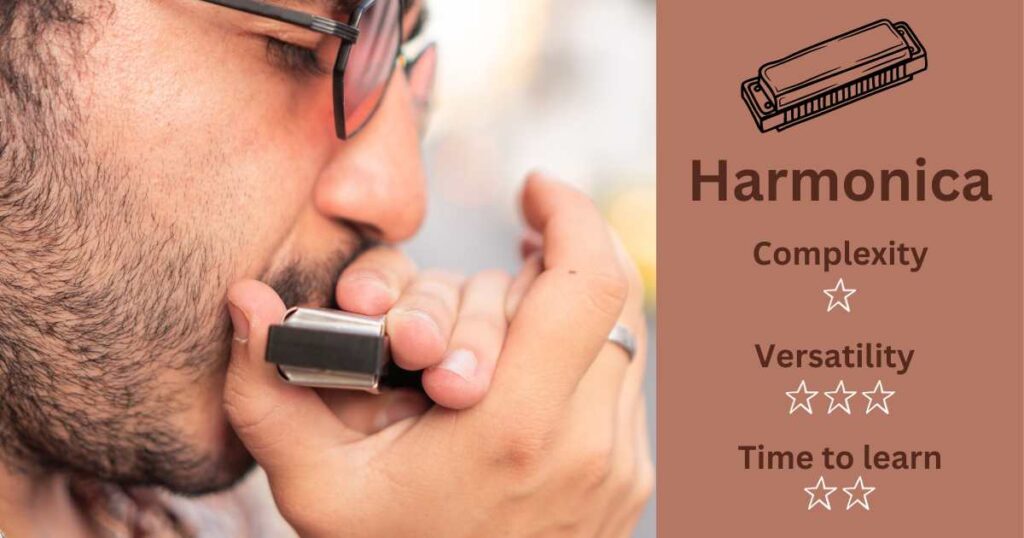
It can be incorporated into many different styles from rock to classical music. With its ten holes that generate major scale notes (C major is the most common), you will easily have access to various tunes and quickly make your own compositions.
Why not explore new sounds with this instrument — it surely leads to fun times!!
2 Drum Kit – Drum Set
Having a drum kit is an enjoyable way to improve rhythm and coordination skills. It’s the most amazing instrument I’ve ever played!!
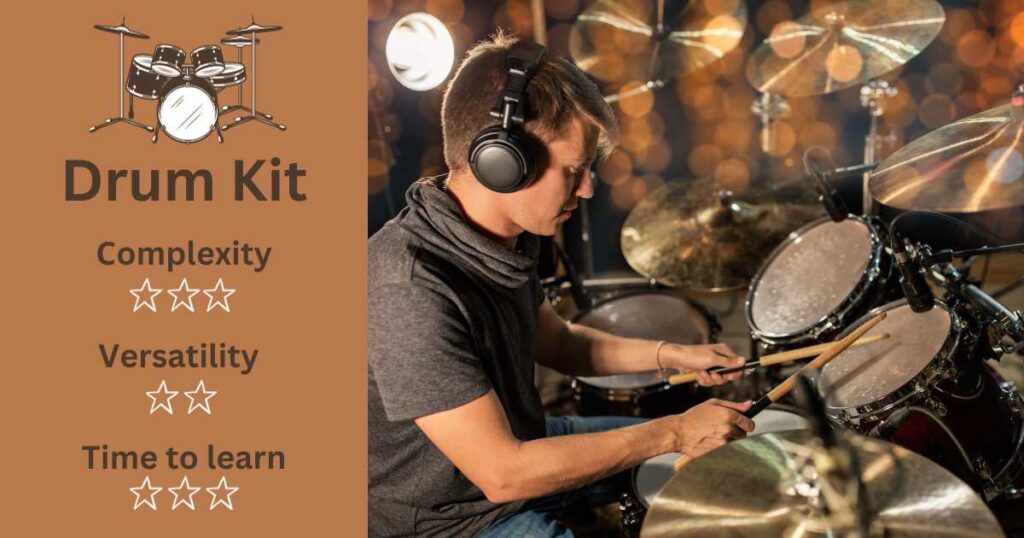
It will occupy quite some space and generate loud noise — make sure your neighbors won’t be bothered by the racket. An electronic drum kit set is another way to reduce noise as can play with headphones.
Practicing on drums regularly will help strengthen your musical capabilities considerably over time.
3 Bongo Drum
If you’re looking for a fun way to develop your sense of rhythm — bongo drums are an ideal starting point (and the easiest instrument to learn).
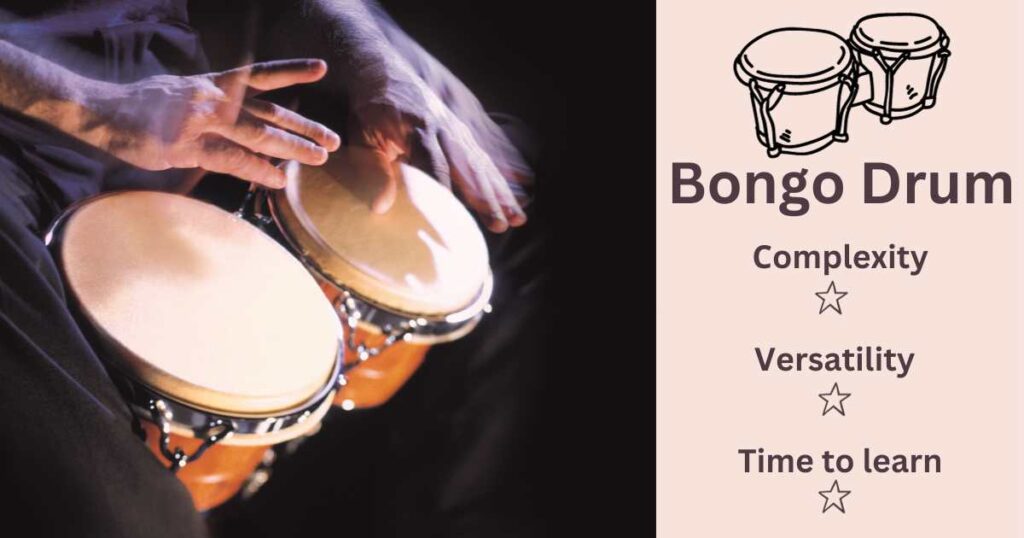
These percussion instruments have two conjoined drums: one small and high-pitched. The other is larger and lower-sounding. They provide a great introduction to drumming without being too noisy — perfect for practicing at home!!
Compared with full drum kits, they require much less coordination but still offer plenty in terms of developing skill and technique. So if you’d like to give it a go – don’t hesitate – grab some bongos today!
4 Triangle – Easiest Instrument to Learn
This percussion instrument has been used in various musical traditions dating as far back as 3000 BC and its simplicity makes it easy for players of any level.
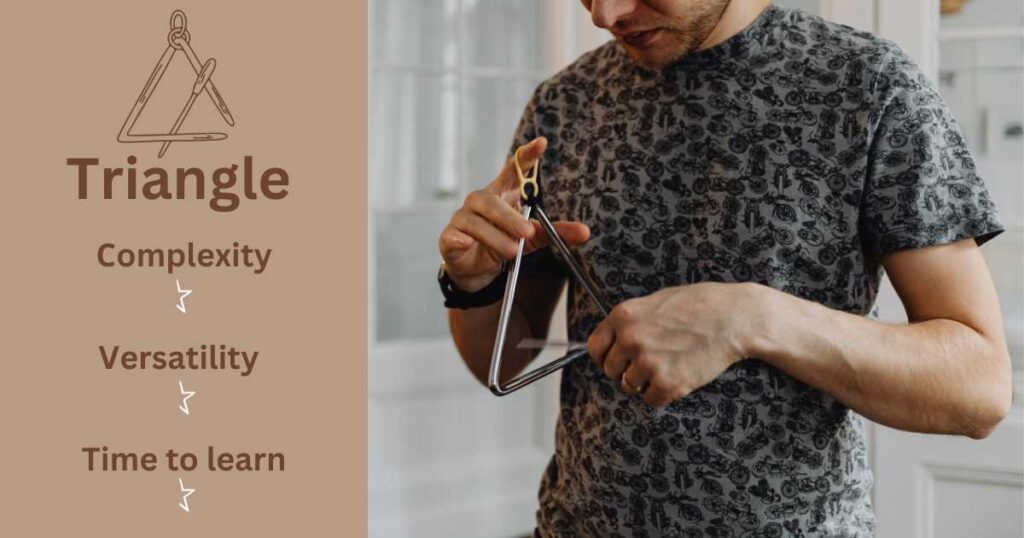
It has three sides, three angles and a wide range of sounds that you can make depending on the material, the size and shape, and the way you play.
This instrument is super popular among musicians — they use it all the time in orchestras, ensembles and bands.
5 Kazoo
The kazoo, a playful and easy-to-play instrument, has been around since 1840.

There are countless possibilities with this fun little invention!! From familiar nursery rhymes like “Row Your Boat” to more complex pieces of music. Explore your own creative voice through the kazoo and play playing without formal training or any special skill set.
If you’re looking for a unique source of entertainment, why not embrace making tunes on your very own kazoo?!
6 Recorder
This instrument has been around for centuries and offers diverse sounds — it’s often a preferred choice of beginners and seasoned music players.
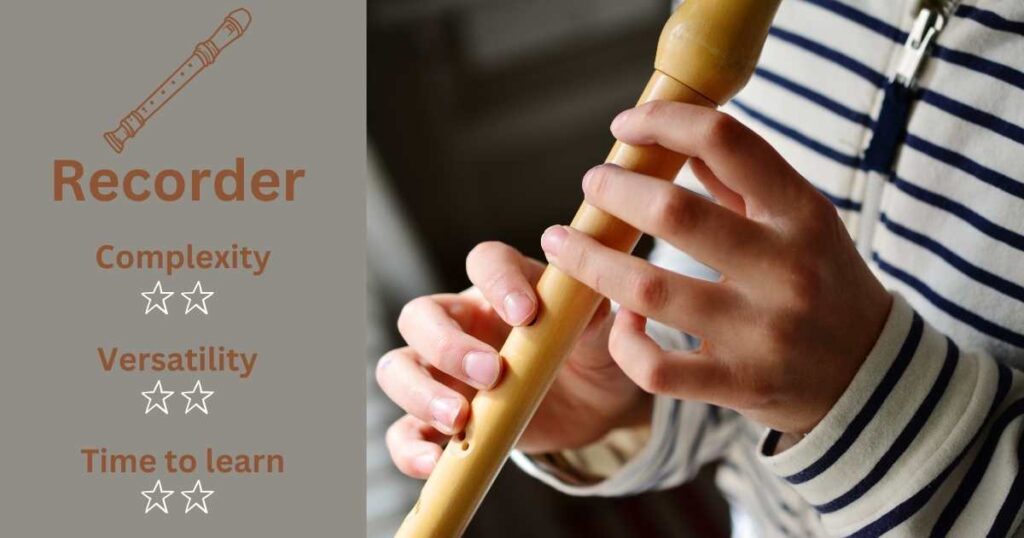
Recorders teach theory basics while helping develop breath control, good lung capacity and listening skills — essential skills that lead to playing other musical instruments too!!
It’s affordable (average price – $20) and its compact size makes it perfect for traveling. So why not give it a try and see the endless possibilities this small but mighty instrument has to offer?!
7 Castanets
Castanets are small wooden percussion instruments used in various European countries since ancient times — they’re easy and fun to learn!!
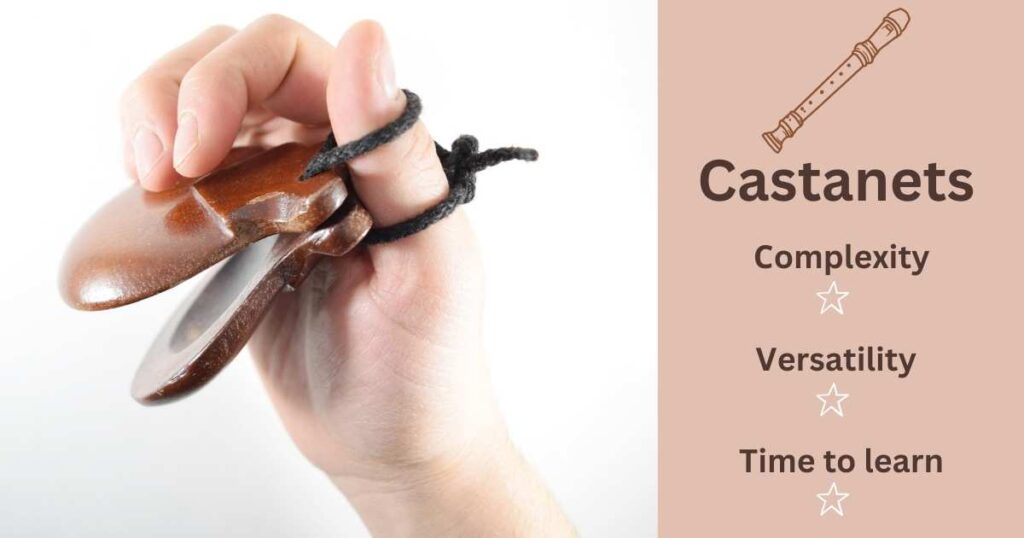
I hear them a lot in flamenco dance and music, musicians also play them in classical, folk and pop music.
Playing castanets gives you the feeling of lively rhythm and excitement. Master them and you’ll set you up for other percussion instruments.
8 Maracas and Shakers
Maracas and shakers are the starting point for rhythm and percussion instruments.
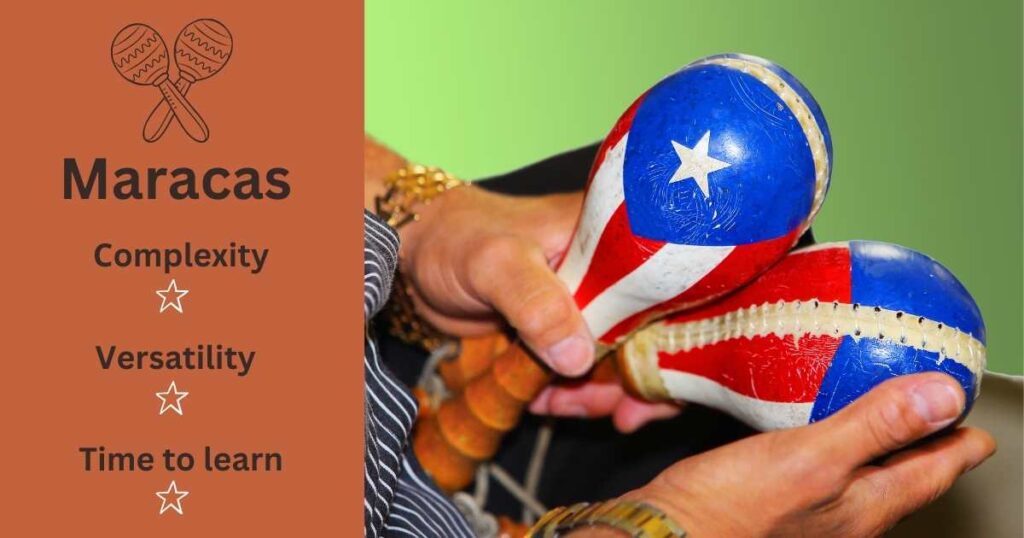
Beginners can learn how to play them with their favorite music genres…
…You can produce a variety of sounds depending on your technique – shaking, hitting or scratching.
Playing maracas and shakers is a way to boost coordination, timing, and focus. Composers often use them in children’s songs — a great choice for young learners.
9 Tambourine
It’s a simple instrument with jingling metal disks around a circular frame. You play them by hand or drumsticks, producing sounds and rhythms.
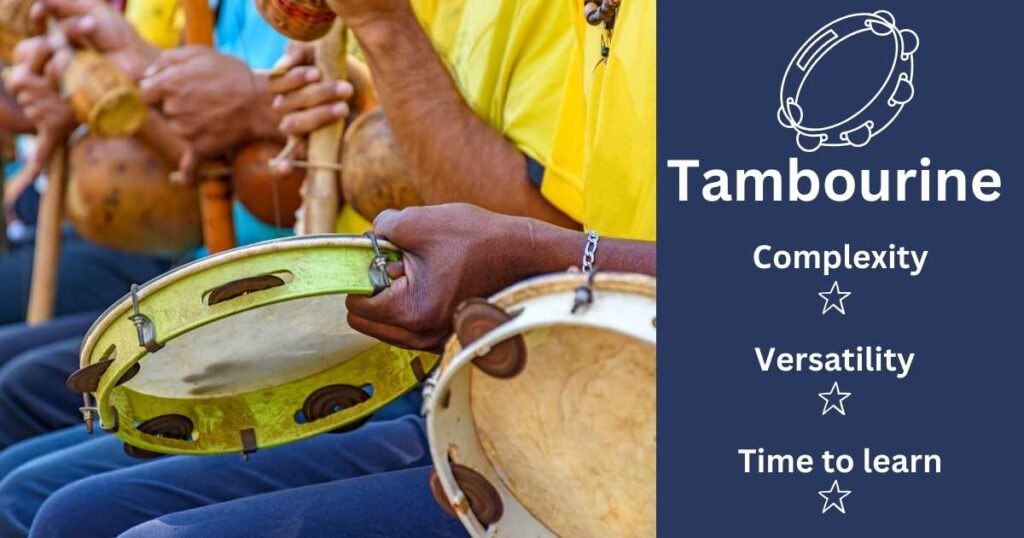
Tambourine’s lightweight and portable – perfect for on-the-go music making! It provides basic playing skills and adds fun elements to your music!
10 Timpani – Kettledrums
Percussion instruments, like timpani or kettledrums, take up a bit more room than smaller percussion pieces. They are large, bowl-shaped bodies with a head stretched over the end.
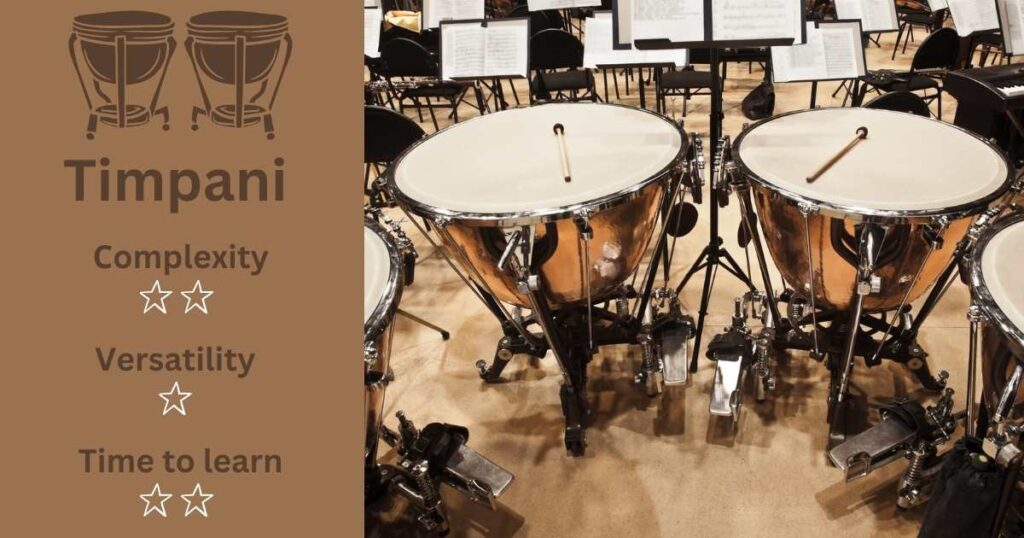
Composers often (since the 17th century in Western classical music) add them to orchestras as they add depth and energy to the music. Learning how to play Timpani does require some effort but their unique sound adds to any performance.
11 Steelpan
The steelpan, originally from Trinidad and Tobago, is a percussion instrument with its own unique sound.
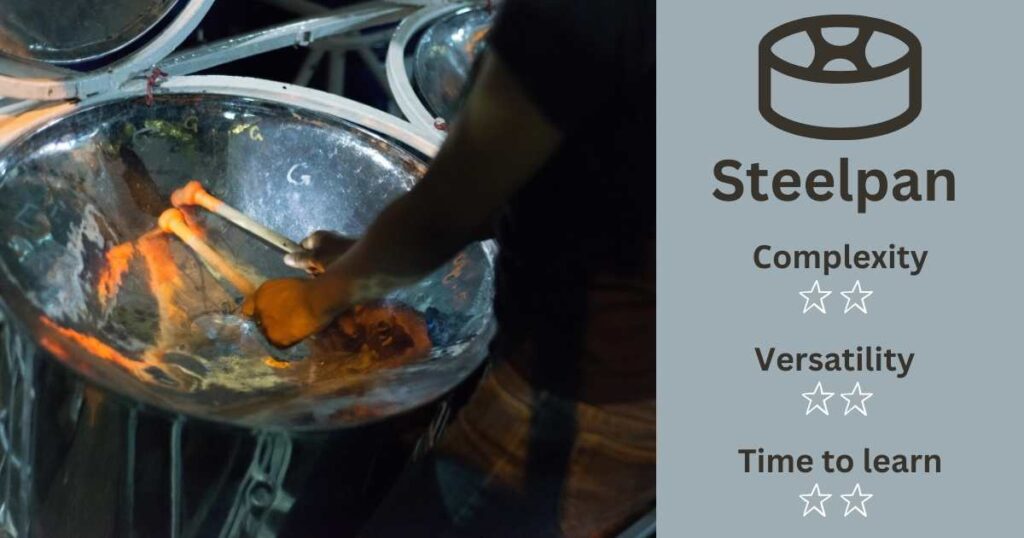
It is made from an oil drum that has been hammered and shaped into a concave shape. Manufacturers divide the playing surface into different sections — each produces a different pitch when you strike it.
The steelpan became popular in the 20th century and I see them a lot in orchestras, ensembles, and even as a solo instrument.
It is one of the easiest instruments to learn, making it perfect for beginners looking for instruments to play.
12 Xylophone
A standard orchestra xylophone has a set of wooden bars arranged like a piano keyboard — great for getting familiar with music theory! Strike wooden bars with mallets to produce sounds.

Music teachers love to use xylophones in music classes to introduce children to the world of percussion. You also spot them quite frequently in orchestras and ensembles.
13 Ukulele
The ukulele is a part of the “guitar family” and originated in Hawaii. Its four strings make it easy to learn chords and melodies (compared to other strings like the guitar).
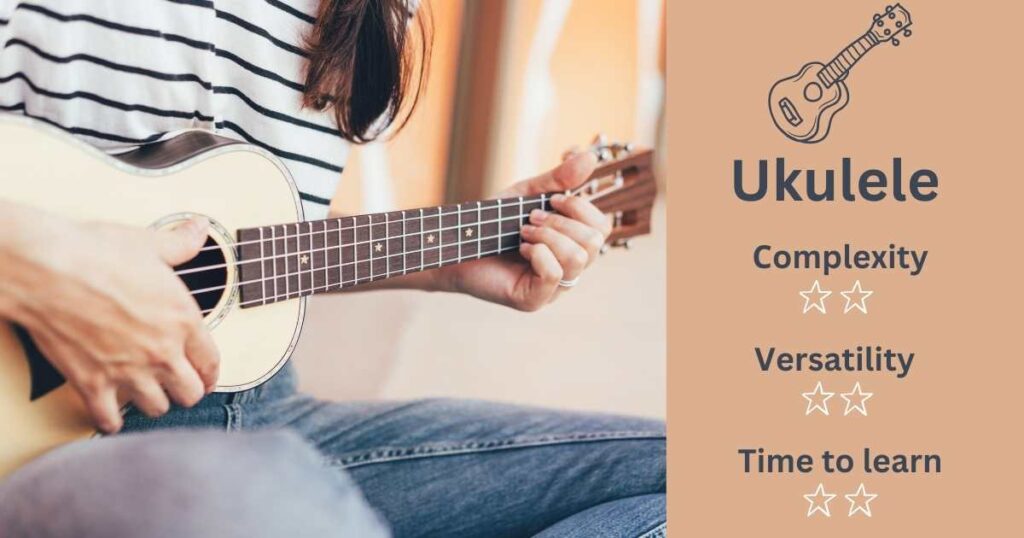
It’s compact and simple design — easy to learn even if you don’t have any musical experience. Take it wherever you go and play on its simple yet flexible tuning system.
14 Flute
Are you into classical music? Then the flute is the right instrument — a great musical instrument to learn!!
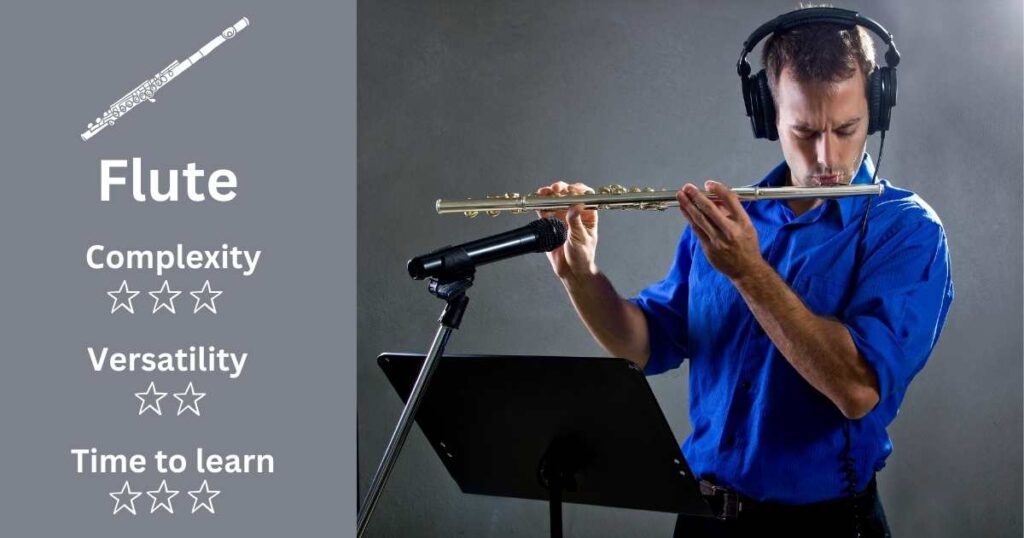
Its small size makes it easy to carry around and practice anywhere at any time. The flute requires more practice than other instruments but produces beautiful sounds and melodies.
Practice regularly and you master playing any melodies. So, if you’re patient and committed to playing it right — you’ll definitely achieve awesome results!!
Are you just getting into flute playing or looking to start out on this journey? Check out my post featuring 9 Best Student Flutes From Reliable Brands
15 Voice
Your own voice is actually the easiest instrument to learn and play…
…You don’t need any external tools or instruments — just your vocal cords and a bit of guidance.
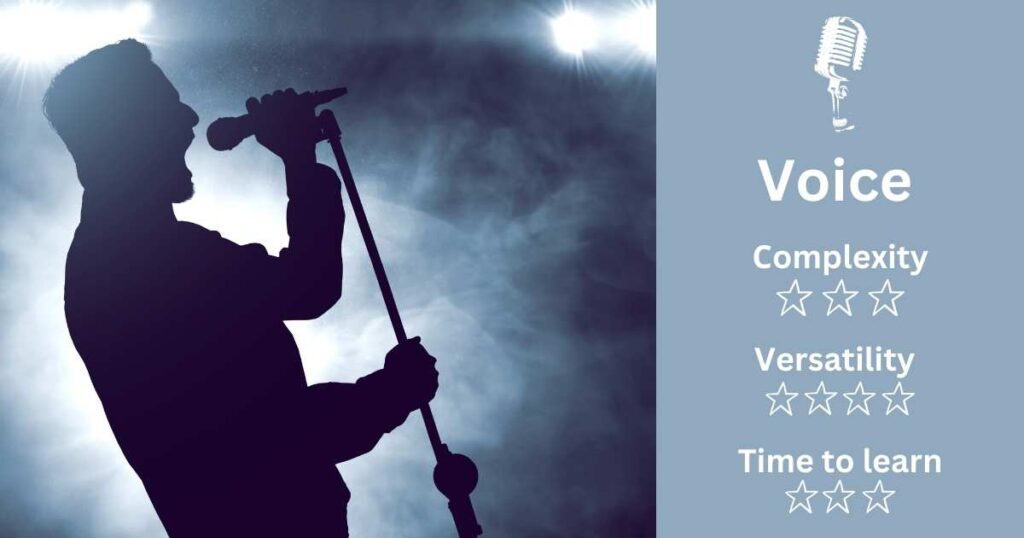
Train your voice to hit high notes, sing in various styles, and develop a unique style of your own.
Plus, singing has tons of health benefits — like improved breathing and stress relief. So go ahead and start singing your heart out!!
17 Acoustic Piano – Grand Piano – Digital Piano
Acoustic piano produces sound by striking the strings with hammers. Tons of resources available for learning make piano a popular choice for beginners.

You find it in various forms — grand, acoustic or digital variations (I love this option — way less noise with a much lower price!!)
You will have to learn music theory (sheet music) as well as the chords and scales.
Regardless if your musical taste lies with classical jazz or modern styles, it will provide you the essential foundation for any journey into music. Practicing on this best instrument provides students great rewards when exploring all types of genres throughout their lives!!
18 Keyboard
Easy to learn and play, keyboards are popular for beginners who want to try out different types of sounds. The compact size and affordable price make them convenient for students with limited space or budget.

Adjust the volume or use headphones for silent practice sessions – all because of its electronic sound production.
With this instrument, you can develop your proficiency in music theory (as well as experiment with different genres).
As you keep moving forward, it opens up access to even more cool features like sampling and music production!!
19 Acoustic Guitar
The acoustic guitar is a popular choice among music schools today.
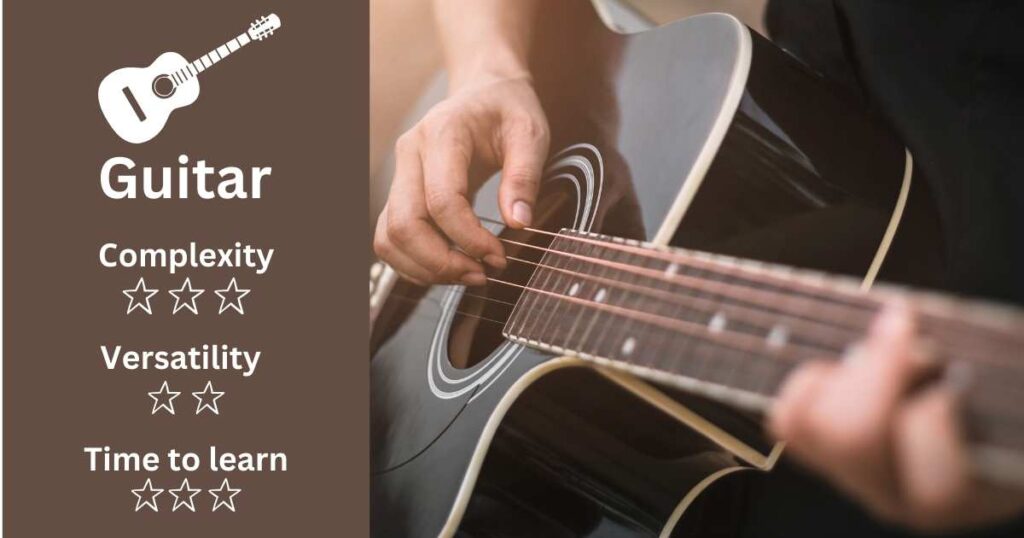
Beginners love the acoustic guitar as it is relatively easy to pick up and play. The strings of acoustic guitars are easier (gentler) on the fingers than electric or bass guitars.
Acoustic guitars produce natural sounds without any need for electricity or amplification due to the hollow body.
An acoustic guitar will always get you started on the music journey!
20 Bass Guitar
The bass guitar supports the harmony of music, being much easier to learn than other guitars. Bass guitars help keep rhythm — an essential part of many genres.
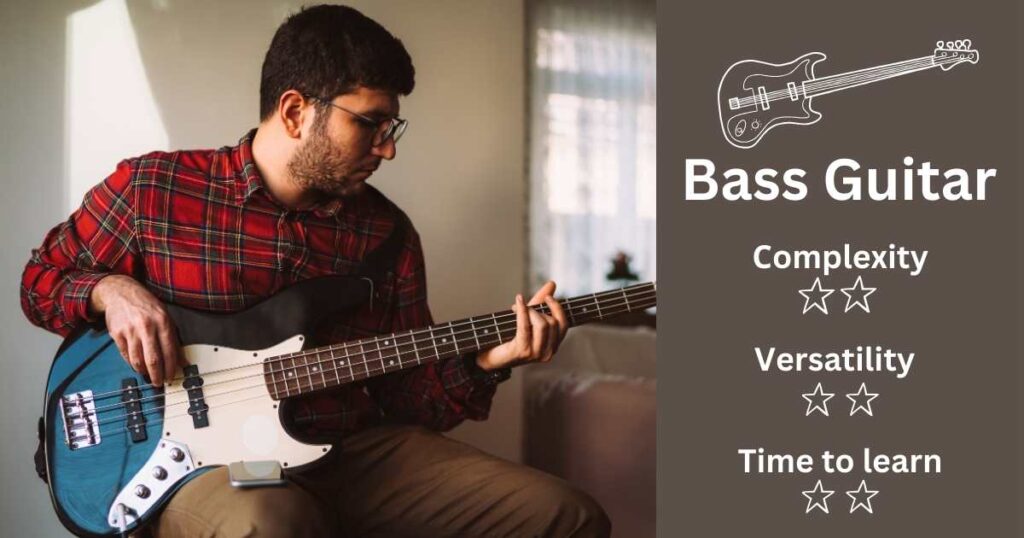
Unlike the guitar or piano, where you play multiple simultaneously, bass playing typically involves playing one note at a time. This lets you concentrate on nailing each note and make progress.
After all, it has four strings and frets just like a regular guitar. However, compared to other instruments, learning the bass is relatively easier.
21 Electric Guitar
The electric guitar is a key part in rock, jazz, blues and country.
If you want to be a rock star — try an electric guitar. The electric guitar is a popular string instrument that needs practice.

You’ll need amplifiers, guitar processors and effects pedals to produce sounds — yeah, it can be a bit pricey, but the payoff is worth it.
Electric guitars have metal strings, which can make them a bit challenging to play – it can be quite painful for your fingertips (at least, it was for mine!)
22 Trumpet
The trumpet is a brass instrument that requires breath control, embouchure and a lot of practice.
At its core, the trumpet is a brass wind instrument that uses air vibration to produce sound. With only three buttons to press, it’s relatively simple to get started and make some sounds.
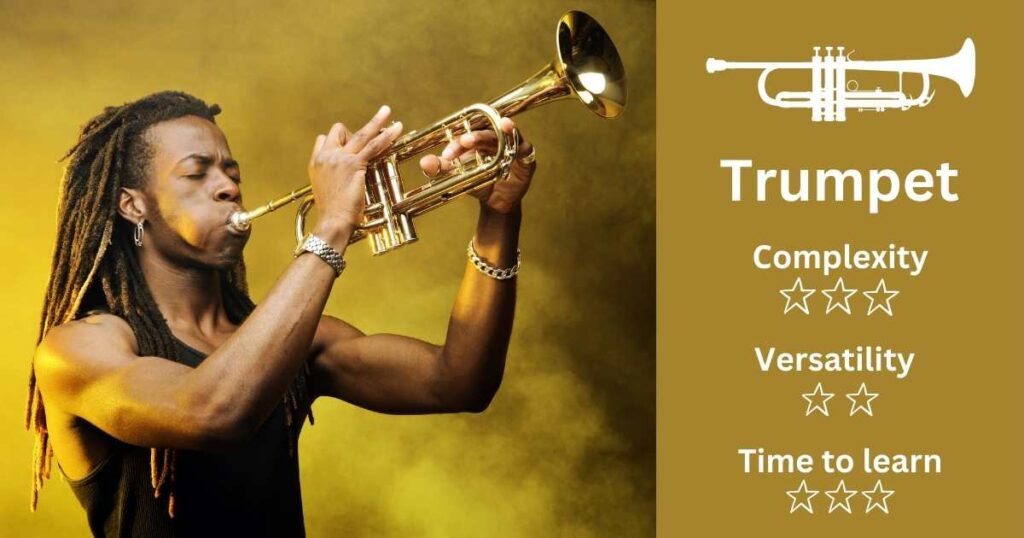
But don’t let its simplicity fool you — the trumpet”’ lead you into many musical genres!!
Challenging but rewarding once conquered — master this instrument and it will grant satisfaction through playing melodious.
Do you want to dive in? Head on over to my post for all of the Best 11 Beginners Trumpets that could make learning easy!
23 Clarinet
Clarinets belong to the woodwind family. But why does learning it seem easy?
First and foremost is its size — unlike larger wind instruments such as the saxophone or French horn, clarinets are compact and lightweight. It’s much easier for younger musicians to manage!!

Unlike string instruments, which involve precise finger positioning, or brass instruments, which require airflow management (and complicated embouchure) — clarinets only require finger placement and breathing techniques.
Clarinets have intuitive fingering systems designed for beginners — each key corresponds with specific notes for quick learning of simple melodies.
24 Alto Saxophone
The alto saxophone is a woodwind instrument known for its melodious, captivating sound. Smaller in scale than its cousin (tenor saxophones), alto saxophones are easier for beginning players to play comfortably and control.
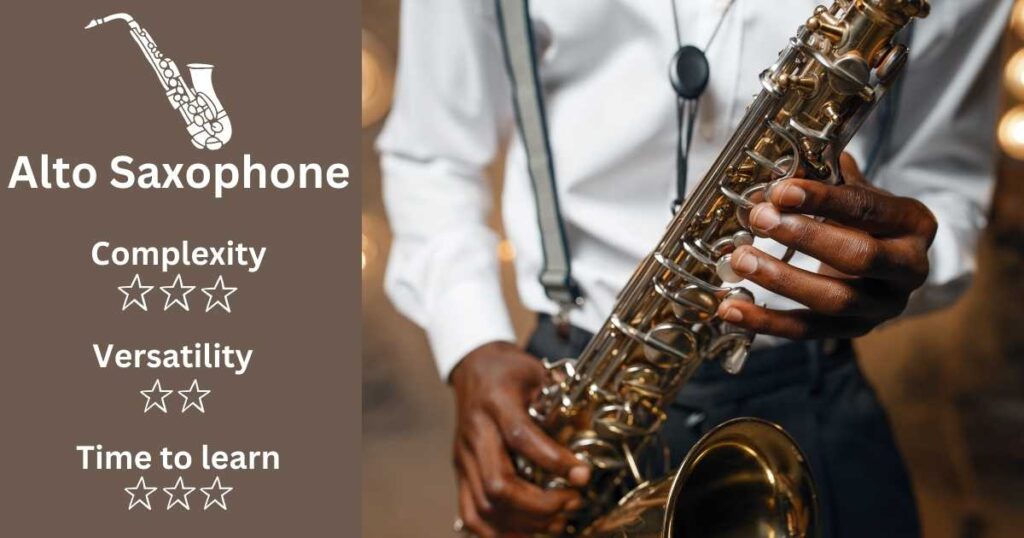
It has a unique curved design. You can play both solo or as part of an ensemble!!
Alto saxophones are compact musical instruments that are easier to hold and manage than larger ones.
Comparable to clarinet or flute playing, saxophone requires more air support and embouchure control.
25 DJ Controller
You may be asking: How is a DJ controller considered an instrument?
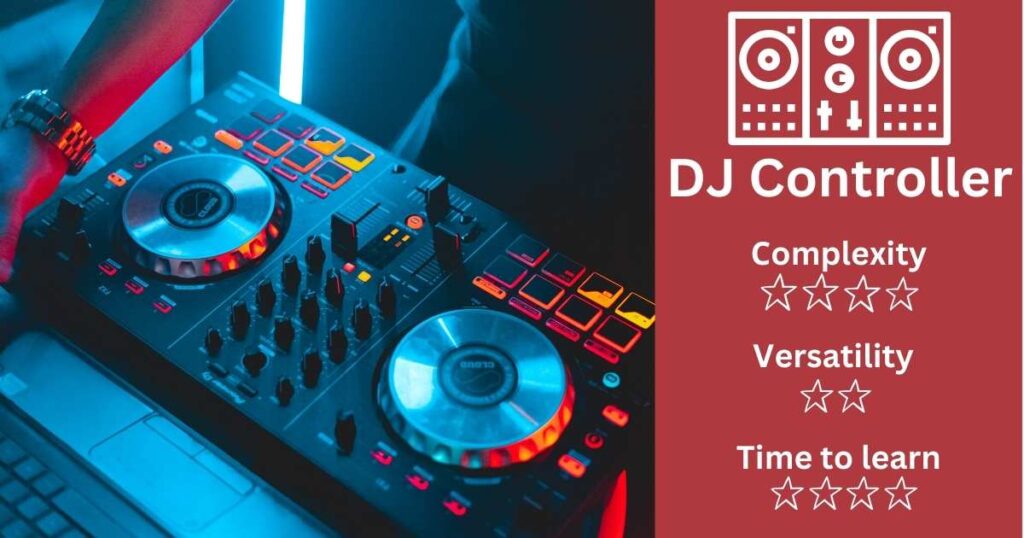
A DJ controller allows you to mix and manipulate recorded music to produce digital tunes. It has keys (at least two octaves), two turntables or jog wheels for scratching tracks together, and buttons and knobs for effects and loops.
You’ll learn how to create seamless transitions and dancing beats!!
Learn with online tutorials and resources available, practice regularly and develop compositions!
26 Violin
A violin is a string instrument of beautiful melodies. It has four strings (E, A, D and G) — you play them either using a bow or by plucking with your fingers.
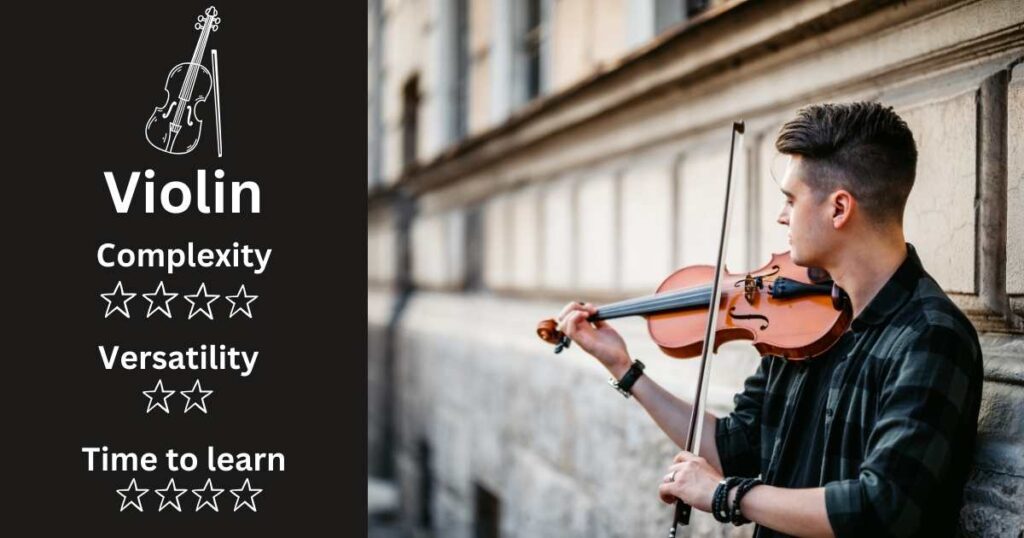
As it lacks frets like guitars, violin learning is way more complex.
Playing violin requires coordination of both your nads — with your left hand pressing down on strings while using a bow with your right hand.
The compact design makes this instrument easily portable for jam sessions or performances.
Don’t let the violin’s classical reputation deceive you — musicians use violins in many styles as folk, rock, jazz and pop.
27 Trombone
A trombone is an instrument with a long cylindrical body with a wide bell. It uses a slide mechanism for pitch changes and glissando effects (the sliding between notes).
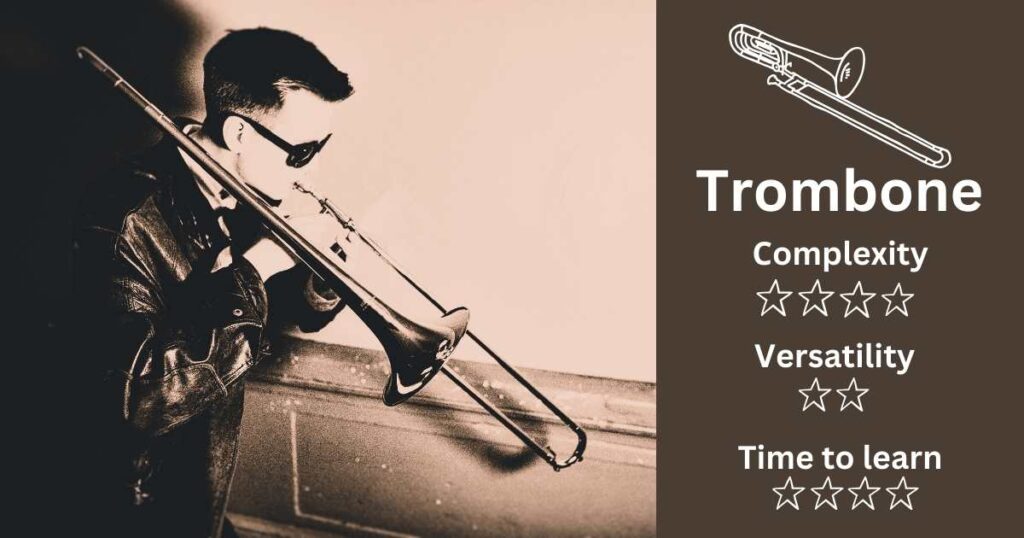
Learning the correct use of embouchure (mouth positioning), hand and slide positions will take some time and practice.
Marching bands, orchestras and jazz ensembles often utilize trombones.
Searching for an unforgettable trombone? Don’t miss my post of 11 affordable models under $1500
Conclusion – Easiest Instrument to Learn
Pick the easiest instrument to learn suitable for you — and try! From bongo drums and harmonicas to more challenging violin or trumpet arrangements. No matter their difficulty levels — practice makes perfect!
Stay focused — success will surely follow!! Give yourself a chance today to see where success may lead.
Frequently Asked Questions (FAQs)
What musical instrument is most difficult to learn?
Mastering five of the hardest musical instruments — accordion, French horn, cello, harp and oboe — requires a lot of effort!!
What are the top three easiest instruments for adults to learn?
Beginners (both adults and kids) often begin with drums (bongo or regular), harmonicas or recorders (woodwind instruments).
These easiest instruments provide adult learners with some of the fun solutions available.
How long typically takes an adult beginner to learn their first instrument?
A musical instrument can take anywhere from one to two years of consistent practice and dedication to become proficient.
Are there any instruments to learn that integrate modern technologies with classical musical education?
DJ Controllers, digital pianos and keyboards make an excellent way to learn music production by combining technology with education concepts.
Each offers an insight into the popular music production area.





